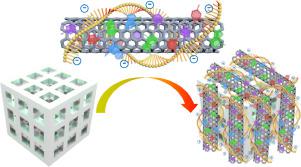Acta Biomaterialia ( IF 9.7 ) Pub Date : 2020-05-16 , DOI: 10.1016/j.actbio.2020.04.047 Xifeng Liu 1 , Matthew N George 1 , Sungjo Park 2 , A Lee Miller Ii 3 , Bipin Gaihre 1 , Linli Li 1 , Brian E Waletzki 3 , Andre Terzic 2 , Michael J Yaszemski 1 , Lichun Lu 1

|
Three-dimensional (3D) printing is a promising technology for tissue engineering. However, 3D-printing methods are limited in their ability to produce desired microscale features or electrochemical properties in support of robust cell adhesion, proliferation, and differentiation. This study addresses this deficiency by proposing an integrated, one-step, method to increase the cytocompatibility of 3D-printed scaffolds through functionalization leveraging conductive carbon nanotubes (CNTs). To this end, CNTs were first sonicated with water-soluble single-stranded deoxyribonucleic acid (ssDNA) to generate a negatively charged ssDNA@CNT nano-complex. Concomitantly, 3D-printed poly(propylene fumarate) (PPF) scaffolds were ammonolyzed to introduce free amine groups, which can take on a positive surface charge in water. The ssDNA@CNT nano-complex was then applied to 3D-printed scaffolds through a simple one-step coating utilizing electric-static force. This fast and facile functionalization step resulted in a homogenous and non-toxic coating of CNTs to the surface, which significantly improved the adhesion, proliferation, and differentiation of pre-osteoblast cells. In addition, the CNT based conductive coating layer enabled modulation of cell behavior through electrical stimuli (ES) leading to cellular proliferation and osteogenic gene marker expression, including alkaline phosphatase (ALP), osteocalcin (OCN), and osteopontin (OPN). Collectively, these data provide the foundation for a one-step functionalization method for simple, fast, and effective functionalization of 3D printed scaffolds that support enhanced cell adhesion, proliferation, and differentiation, especially when employed in conjunction with ES.
Statement of Significance
Three-dimensional (3D) printing is a promising technology for tissue engineering. However, 3D-printing methods have limited ability to produce desired features or electrochemical properties in support of robust cell behavior. To address this deficiency, the current study proposed an integrated, one-step method to increase the cytocompatibility of 3D-printed scaffolds through functionalization leveraging conductive carbon nanotubes (CNTs). This fast and facile functionalization resulted in a homogenous and non-toxic coating of CNTs to the surface, which significantly improved the adhesion, proliferation, and differentiation of cells on the 3D-printed scaffolds.
中文翻译:

用于骨组织工程的具有碳纳米管的 3D 打印支架:快速且均匀的一步功能化。
三维(3D)打印是一种很有前途的组织工程技术。然而,3D 打印方法在产生所需的微尺度特征或电化学特性以支持强大的细胞粘附、增殖和分化的能力方面受到限制。本研究通过提出一种集成的一步式方法来解决这一缺陷,该方法通过利用导电碳纳米管 (CNT) 的功能化来提高 3D 打印支架的细胞相容性。为此,首先用水溶性单链脱氧核糖核酸 (ssDNA) 对 CNTs 进行超声处理,以产生带负电荷的 ssDNA@CNT 纳米复合物。同时,3D 打印的聚富马酸丙二醇酯 (PPF) 支架被氨解以引入游离胺基团,它可以在水中带上正表面电荷。然后通过利用静电力的简单一步涂层将 ssDNA@CNT 纳米复合物应用于 3D 打印支架。这种快速简便的功能化步骤导致碳纳米管表面均匀且无毒的涂层,显着改善了前成骨细胞的粘附、增殖和分化。此外,基于 CNT 的导电涂层能够通过电刺激 (ES) 调节细胞行为,从而导致细胞增殖和成骨基因标志物表达,包括碱性磷酸酶 (ALP)、骨钙素 (OCN) 和骨桥蛋白 (OPN)。总的来说,这些数据为支持增强细胞粘附、增殖、
重要性声明
三维(3D)打印是一种很有前途的组织工程技术。然而,3D 打印方法产生所需特征或电化学特性以支持稳健的电池行为的能力有限。为了解决这一缺陷,目前的研究提出了一种集成的一步法,通过利用导电碳纳米管 (CNT) 的功能化来提高 3D 打印支架的细胞相容性。这种快速而简便的功能化使 CNT 均匀且无毒地覆盖在表面,从而显着改善了 3D 打印支架上细胞的粘附、增殖和分化。



























 京公网安备 11010802027423号
京公网安备 11010802027423号